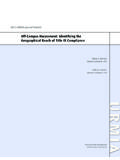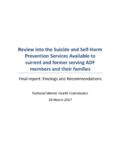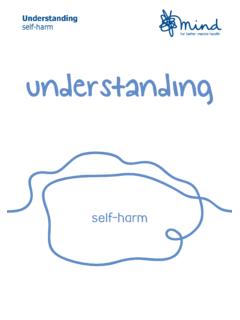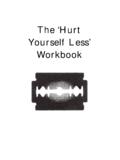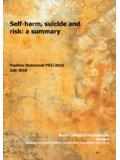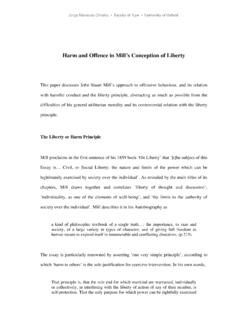Transcription of Direct Threat and Caring for Students At Risk for Self ...
1 National Association of College and University Attorneys September 3, 2014 | Vol. 12 No. 8 TOPIC: Direct Threat AND Caring FOR Students AT RISK FOR self -HARM: WHERE WE STAND NOW AUTHOR: Paul G. Lannon, Jr. INTRODUCTION: For many years, the legal framework by which colleges and universities addressed Students at risk for self -harm was well recognized and fairly well understood: If Students posed a " Direct Threat " a significant risk of substantial harm to the health or safety of themselves or others, then the institution could take reasonable steps to diminish that Threat without violating federal anti-discrimination laws. Then, in March 2011, the Department of Justice ( DOJ ) fundamentally changed the legal framework in which colleges and universities could address Students at risk for self -harm without running afoul of federal disability discrimination laws.
2 At issue was the definition of Direct Threat when is a student no longer qualified because he or she poses a Direct Threat to health or safety? Previously, schools relied on the long-standing interpretation of the phrase by the Department of Education, Office of Civil Rights ( OCR ) that Direct Threat includes both a Threat to others and a Threat to self . OCR s interpretation was consistent with how the Equal Employment Opportunity Commission has defined Direct Threat in the workplace, an interpretation that was upheld by the Supreme Court.[1] The DOJ upset this legal framework by defining Direct Threat for the purposes of Title II of the Americans With Disabilities Act (applicable to public institutions) to include only those disabled Students who pose a significant risk to the health or safety of others, omitting any reference to a risk of self -harm.
3 The 2011 Title II regulations and how they affect the Direct Threat analysis for colleges and universities were examined in depth in a November 2011 NACUANOTE.[2] Where do we stand now? Three years later, OCR has stopped referring to and relying on a Direct - Threat -to- self analysis, but there is still no formal guidance from OCR or the DOJ regarding how colleges and universities, without applying a Direct Threat analysis, can properly care for Students at risk of self -harm while maintaining compliance with disability laws. How, then, should institutions answer this question in the absence of formal guidance? This Note reviews the current regulatory environment, examines the few self -harm cases that OCR has investigated since the regulatory change took effect in March 2011, and proposes some guidelines for safeguarding Students and avoiding disability discrimination claims in the absence of formal federal guidance.
4 DISCUSSION: 1. NACUA s Efforts to Obtain Federal Guidance Following the publication of the November 2011 NACUANOTE on this subject, a group of NACUA and NASPA members met with OCR leaders to discuss the need for more guidance on Direct Threat -to- self situations. The meeting did not result in any concrete recommendations or guidance from OCR. Meeting attendees sent a follow-up letter in February 2012, outlining several issues of immediate importance to colleges and universities. These included: The commitment to creating a safe, nondiscriminatory environment for Students ; The need for affirmative institutional action when Students pose a Threat to themselves; Parental expectations that institutions will take action in the face of known risks; The practical necessity of emergency removals when Students in physical or emotional distress refuse to engage with counseling or other needed medical services; The reality that institutions of higher education are not residential in-patient treatment facilities and that some Students cannot safely stay on campus.
5 The fact that threats to self can become threats to others, leading to an inability to clearly distinguish between self -harming and generally threatening Students ; Questions about the viability of reentry or readmission conditions when Students leave campus and then seek to return; and The necessity of maintaining involuntary withdrawals as a last resort to facilitate safety on campus. These and other issues remain pressing. They are frequently the focus of student complaints and OCR investigations, as represented in the cases analyzed below. 2. Recent OCR Resolution Agreements Involving self -Harm Since the DOJ Title II regulations were published in September 2010, OCR has issued a handful of decision letters and resolution agreements involving complaints of disability discrimination by Students considered at risk for self -harm.
6 While resolution agreements may not be relied upon as legally binding precedents,[3] they do provide insight on how OCR is analyzing these situations and what steps taken by colleges and universities have met with approval or disapproval. A few consistent principles can be discerned in these decisions and, absent formal guidance from the OCR, may provide some much-needed help to institutions grappling with similar circumstances. Spring Arbor University (December 16, 2010) Spring Arbor University was the first OCR resolution agreement (of which this author is aware) addressing self -harm that was issued publicly after the new Title II regulations were published.
7 Conspicuously absent is any reference to a Direct Threat to self . Consequently, Spring Arbor is frequently cited as a watershed case the case where OCR stopped using a Direct Threat -to- self -analysis. In Spring Arbor, OCR investigated a complaint of disability discrimination against a private university subject to Section 504 of the Rehabilitation Act of 1973. The Complainant disclosed in his admission materials some information about his medical history, but after his enrollment, did not identify himself as a student with disabilities or request any specific accommodations.[4] Having received complaints from Students about the Complainant s disruptive behavior, University officials met with the student and required him to enter into a behavior contract as a condition of continued enrollment.
8 [5] The proposed behavior contract included the following obligations: (1) attend mandatory therapy; (2) provide written confirmation of attendance from a therapist; (3) provide a release permitting the Director of the Health Center to discuss his case with the therapist; (4) comply with his therapist s treatment plan; (5) maintain composure during classes; (6) avoid stressful social situations that might trigger a crisis; and (7) contact certain University officials when in a crisis situation. Rather than submit to the behavior contract, the student withdrew from the University. No restrictions were placed on his return at the time he withdrew. He was in good academic standing and faced no disciplinary charges.
9 When the student sought readmission, Spring Arbor imposed upon him the same conditions contained in the behavior contract, including documentation that he was receiving appropriate medical treatment and was able to resume a full course load. Spring Arbor s readmission policy did not contain any references to documentation of medical treatment. The University had, nevertheless, imposed similar conditions on at least two other Students , both of whom were suspected of having psychiatric disabilities and who had withdrawn from the University. No determination was made as to whether the Complainant posed a Threat to others, but the University believed that the student had demonstrated that he was a Threat to himself.
10 [6] Without mentioning Direct Threat to self , OCR recited the Direct Threat -to-others analysis[7] and determined that Spring Arbor could not avail itself of that defense because the University had failed to conduct an individualized assessment based on current medical advice or the best available objective evidence.[8] OCR also assessed the disability discrimination claim under a disparate treatment analysis, asking whether similarly-situated, non-disabled Students were treated differently.[9] OCR found that the University perceived the Complainant as a qualified student with a mental impairment and then, on the basis of that perception, treated him differently from other Students who were disruptive or withdrew.



